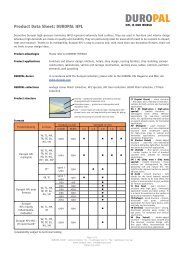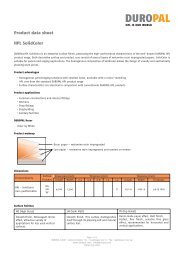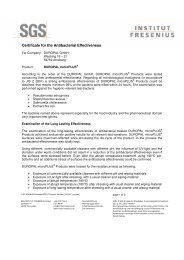duropal - Hpl- tecHno- loGY
duropal - Hpl- tecHno- loGY
duropal - Hpl- tecHno- loGY
Create successful ePaper yourself
Turn your PDF publications into a flip-book with our unique Google optimized e-Paper software.
7. PROCESSING Duropal-HPL AND Duropal-HPL-ELEMENTS<br />
7.1 GENERAL<br />
Duropal-HPL in thicknesses less than 2 mm needs a level, tension-free core material with<br />
minimum flex. A smooth surface is one of the main prerequisites for permanently good<br />
results; the right adhesive, quantity applied, forming pressure and press temperature are<br />
equally important.<br />
Please take into account when processing Duropal-HPL that temperature and humidity may<br />
cause some slight dimensional changes in it.<br />
7.2 CORE MATERIAL<br />
The following table illustrates the suitability of various materials as cores and their application<br />
possibilities. In all instances, please remember that the properties of a core material consisting<br />
of various components (e.g. honeycomb with frame) may have different effects on the<br />
surface of Duropal-HPL. This should be checked first, and must be taken into account.<br />
MATERIAL/CONSISTENCY AND SUITABILITY AS A CORE<br />
Chipboard<br />
The necessary thickness is to be taken into account on self-supporting constructions. The<br />
fixing of the flat bonded elements is determined by the thickness and size of the panel. The<br />
surface quality of the Duropal-HPL-element is determined largely by the structure of the<br />
chipboard panel, i.e. the shape of the chips, amount of resin, density and - above all - the<br />
sanding quality of the surface. Multiply chipboard is suitable as the core. The boards should<br />
be evenly sanded on both sides in order to prevent bowing and visual surface defects.<br />
In order to facilitate a short bonding and pressing time, ensure that the surface has good<br />
absorption properties if you are going to use a water-based bonding system. The top layer<br />
must have a minimum resistance to delamination of 1.2 N/mm in order to prevent the laminate<br />
from delaminating (DIN 52366).<br />
Should you have any questions concerning these special chipboard panels, please contact us.<br />
_ 24










